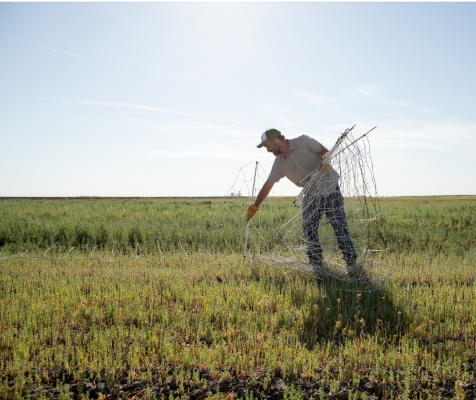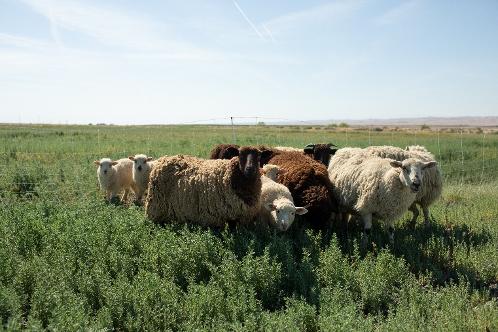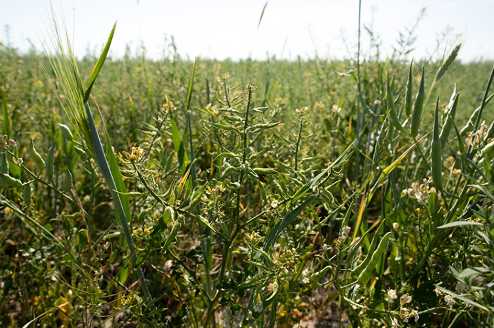Practices: No-till, animal integration, alley cropping, poly cropping, composting, and cover cropping
Nathanael Siemens is an organic grower juggling a variety of crops, fields, and systems across California. He has a 150 acre farm in Modoc County and another 10 acres in Kern County. He is also working at the Rodale Institute's new farm research center in Ventura County.
He grew up on a farm in Kern County but left for college and only returned to farming 15 years ago. When he first got back into farming, he was doing management for other growers and didn't have the capacity to change up existing practices. Later on, he was hesitant to make big changes since the conventional system was already functioning.
This all changed during the recent drought, when it became clear to Nathanael that conventional farming was no longer viable. He started thinking outside the box by doing dry farming and implementing practices that build up organic matter. He also started planting multiple crops at once so that they don't all fail at the same time.
Practices
In Modoc, Nathanael dry farms grain crops. Dry farming is common in that area, but he also does no-till on this farm, which is less popular. He's also begun planting trees in the grain fields as part of an alley cropping system. He brings sheep onto the fields to graze after harvest.
In Buttonwillow, on the western side of Kern County,Nathanael grows grains, along with cotton and corn. He tried poly cropping, where he planted a wide variety of grains all together in one field. He reported that this was a fun practice, but he ended up only being able to sell about 5% of the product since the market for organic mixed grains hasn't materialized yet. He used the rest of the harvest for animal feed. He planted this mix of grains to reduce the likelihood of total crop failure. He tried doing reduced till in his cotton field here last year, but it didn't work out very well because of intense weed pressure. For this reason, he's scaling this experiment down to just 2 acres this year. The rest of the field is in corn. He hasn't transitioned to a no-till system for his corn yet, since this practice is more popular and thus less exciting to try out.
He implements a wide variety of conservation practices, but didn't start them all at the same time. The first practice he implemented was cover crops, 5 years ago. Then he started transitioning to no-till 4 years ago. He started planting poly crops 3 years ago, incorporated sheep into his systems 2 years ago, and started spreading compost one year ago.
Effects
Yield
Nathanael has seen an instant yield increase after implementing poly cropping. It has been harder to see the immediate effects on yield of compost and cover cropping.
He sells most of his grain at farmers' markets. This niche market supports farmers who have an interesting or compelling narrative. Farmers' market customers will pay a higher price for dry farmed crops.
Pests
Poly cropping/intercropping cotton has encouraged more biodiversity. In Buttonwillow, in Kern County, he has noticed a huge difference between his field and his neighbors' fields. There are more beneficial insects and birds in his field. Last year, his cotton suffered no insect damage.
Erosion
These practices, especially cover cropping and no till, have led to a noticeable decrease in wind erosion. This helps to improve the local air quality.
Water
In Modoc, Nathanael has seen a positive impact of these practices on his dry farmed grains. Wherever there is more mulch on the surface because of his no-till and poly cropping practices, he has noticed that there is more water in the soil. The crops therefore stay green longer.
Weeds
As already mentioned, the reduced till regimen for cotton didn't work out last year because the cotton was overwhelmed by weeds.
However, Nathanael has seen in his grain fields in Modoc that no till has reduced weed problems after the first year. The first year of no till there was difficult, but once the mulch layer gets established, it keeps weed seeds from germinating, especially the annual weeds that normally take over disturbed soils.
Profitability
Once Nathanael started bringing in sheep to graze his fields, he gained an extra income stream. This practice brings in additional revenue but only requires minimal additional inputs.
Overall, he said that these practices have helped the farm's bottom line. It's hard to determine the exact dollar amount because it has been a total lifestyle change. Instead of spending hours on a tractor, he's now spending that time talking to customers and managing animals.
Difficulties
Nathanael explained that there has been a steep learning curve in implementing these practices and that he is still on the steep part of that curve, especially for animal management. As he's found with his poly cropped grains, marketing his products has been a challenge. However, the farm has managed to find good opportunities to sell their niche products to people willing to pay for them.
Recommendations
He would recommend these practices to other growers. He would advise reaching out to consultants and other resources to learn from experts. Also, he learned that it is easier and more efficient to contract out instead of doing everything himself. This has been especially true with the sheep grazing, since he had not dealt with sheep before. He also pointed out that many regenerative practices aren't new, they're just not generally paired together like he's been doing.
He would advise trying a practice out on a few acres and seeing the results for yourself.


